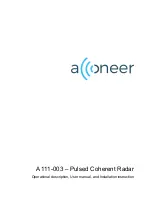
Revision 1.0
8
Copyright FlexRadio Systems, 2010-2011
significant bit is actually the ~read/write bit, but is always presented as a “0” when the
address is expressed. The TAS1020B is the I2C Bus Master and is always connected to
the I2C Multiplex Chip and the EEPROM.
When the Bus Mux is set to “Outside,” the I2C bus is routed to the appropriate pins on
the FlexWire connector. When set to “Inside” the I2C bus is routed to the CODEC, and
the two Bus Expanders, which convert I2C commands to many high/low outputs used to
control the individual switches that control signal routing in the radio.
The Audio Amplifier is controlled by general purpose outputs from the CODEC.
SPI Bus
There is also a SPI bus, used to control the DDS and the RFPA. It appears as two
physical instances, a 3.3V version and a 5V version. The SPI is outbound control only,
for both the AD9951 DDS and RF PA board.
The AD9951 DDS is controlled via the 3.3 Volt SPI bus, directly from the CPU.
The DDS can be programmed to operate with either a 20 MHz or 38.4 MHz reference
input. The 20 MHz signal comes from doubling the external 10 MHz input, and the 38.4
MHz is generated by an onboard temperature compensated crystal oscillator.
The TPIC6B595 Relay Driver is controlled by the 5 Volt SPI bus, and controls the
following relays according to the band of operation or transmit/receive status.
A “High” SPI control bit is the active state, which provides a LOW output from the relay
driver to turn the relays ON.
I.C. Name
Bit
Pin
Name
Function
Initial
Drain0
0
4
15M
Active = 17 or 15 Meter Band
0 = Inactive
Drain1
1
5
160M
Active = 160 Meter Band
0 = Inactive
Drain2
2
6
20M
Active = 30 or 20 Meter Band
0 = Inactive
Drain3
3
7
6M
Active = 6 Meter Band
0 = Inactive
Drain4
4
14
80M
Active = 80 Meter Band
0 = Inactive
Drain5
5
15
10M
Active = 12 or 10 Meter Band
0 = Inactive
Drain6
6
16
XMIT
HIGH = Transmit mode, LOW = Receive mode
0 = Receive
Drain7
7
17
40M
Active = 60 or 40 Meter Band
0 = Inactive
RF Signal Processing
The incoming RF signals may be received via the antenna connector on the RFPA board,
the transverter receive connector, or the transverter common connector. These signals are
routed via the appropriate bandpass filter, then either directly to the preamp, or through a
Summary of Contents for FLEX-1500
Page 5: ...Revision 1 0 5 Copyright FlexRadio Systems 2010 2011...
Page 6: ...Revision 1 0 6 Copyright FlexRadio Systems 2010 2011...
Page 17: ...Revision 1 0 Copyright FlexRadio Systems 2010 2011 Appendix A Schematic PTRX Transceiver Board...
Page 32: ...Revision 1 0 Copyright FlexRadio Systems 2010 2011 Appendix B Schematic PPA05 RFPA Board...
Page 38: ...Revision 1 0 Copyright FlexRadio Systems 2010 2011 Appendix C PC Board Component View...
Page 39: ......
Page 40: ...1 2 3 1 2 3 FlexRadio Systems Copr 2010...
Page 41: ...Revision 1 0 Copyright FlexRadio Systems 2010 2011 Appendix D Test Points...
Page 42: ...FlexRadio Systems Copr 2010 1...
Page 43: ...1 2 3 1 2 3 FlexRadio Systems Copr 2010...
Page 44: ...Revision 1 0 Copyright FlexRadio Systems 2010 2011 Appendix E Test Fixture...
Page 48: ...Revision 1 0 Copyright FlexRadio Systems 2010 2011 Appendix F Bill of Materials...









































